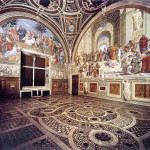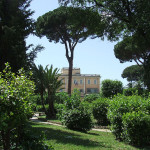St. John Lateran’s Basilica
Data Pubblicazione giugno 28, 2014The Papal Archbasilica of St. John Lateran (Arcibasilica Papale di San Giovanni in Laterano), usually known as St. John Lateran’s Archbasilica, St. John Lateran’s Basilica or simply The Lateran Basilica, is the church of the Diocese of Rome as well as the ecclesiastical seat of the Pope. Regarded as the Mother of All Churches by the Catholic Church, the Lateran Basilica was erected in the 4th century.
The cathedral is open every day of the week from 7:00 a.m. until about 6:00 p.m. Admission to the cathedral is free, but note that there is a charge to visit its cloisters. Don’t forget that this is an active church and access can be denied or limited during specific events or services.
When visiting the Papal Archbasilica of St. John Lateran , climb the Holy Stairs (Scala Sancta). The Holy Stairs are the stairs that Jesus Christ climbed during his trial in Jerusalem. It is alleged that the 28 marble steps, now protected and covered with by wood for preservation, were at Pontius Pilate’s house in Jerusalem and that Christ ascended them the day he was brought before Pontius Pilate. According to tradition, Roman Emperor Constantine I’s mother St. Helen brought these steps from Jerusalem to Rome, and they have been in this location since year 1589. The steps can only be climbed on the knees, a popular practice to many pilgrims from all over the world. Be advised that pilgrims climbing the Scala Sancta on their knees may create long lines, especially during Lent and on Fridays. The steps are bordered by other staircases, which are open to the public. This is regarded as one of the holiest religious sites in Christendom. The Holy Stairs is open to the public on a daily basis from 6:15 a.m. to noon and from 3:30 p.m. until 6:30 p.m. Then, explore the Lateran Baptistery, founded the Emperor Constantine in the 4th century. Situated outside the northeast façade of the church, the Lateran Baptistery, with its octagonal structure topped by a dome, is connected to San Giovanni in Laterano by a covered walkway. The Baptistery owes its octagonal shape to eight columns topped by Corinthian capitals. And then tour the cloisters, surrounded by twisted columns made from inlaid marble.
Related Posts
Rome Tour

Climb Saint Peter’s chapel
Rome top view is totally breath taking: your eyes will look right into Conciliazione’s street where you can ...Auditorium Parco della Musica
It is a multifunctional complex in Pietro de Coubertin street (official web site: auditorium.com): through this creation, Rome ...
CASTEL SANT’ANGELO’S TERRACE
You cannot miss Castel Sant Angelo if you are visiting Rome. In fact in its main entrance has tons ...
Musei Vaticani: le Stanze di Raffaello
It’s some kind of magic experienced in here that gives to the visitor a feeling that never goes ...
A Museum in Roma in Trastevere
The Museum of Roma In Trastevere (Piazza Sant'Egidio 1/b) it is a very characteristic place. Here there is ...
Santa Maria dell’Immacolata Concezione’s church
When you step in this church you will remain astonished from the beauty of the structure but either ...
CRYPTA BALBI, NATIONAL ROMAN MUSEUM
Only one block that contain the whole Roman history: the crypt it is none other than a Lucio ...
VILLA CELIMONTANA
While walking around Villa Celimontana (by Via della Navicella, 12) it is possible that you end up under ...
Monster’s house – Palazzo Zuccari
It is located at the bottom of Trinità dei Monti along Sistina and Gregoriana’s street, and it is ...







